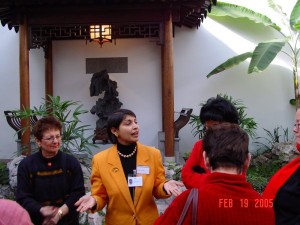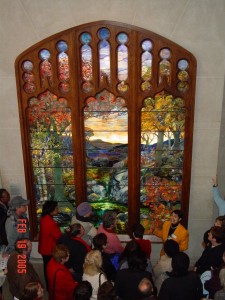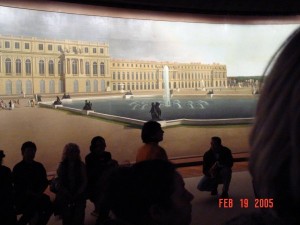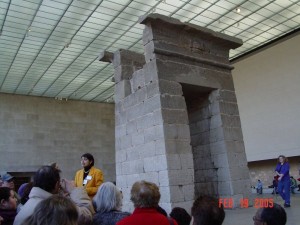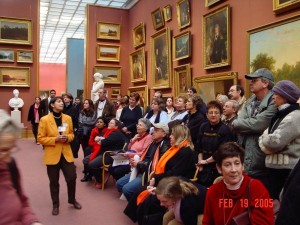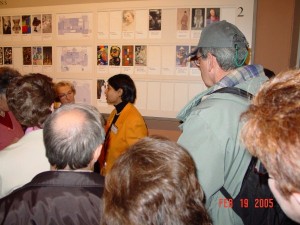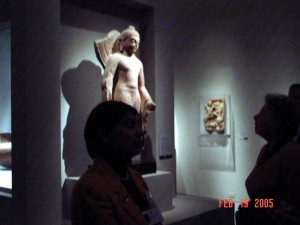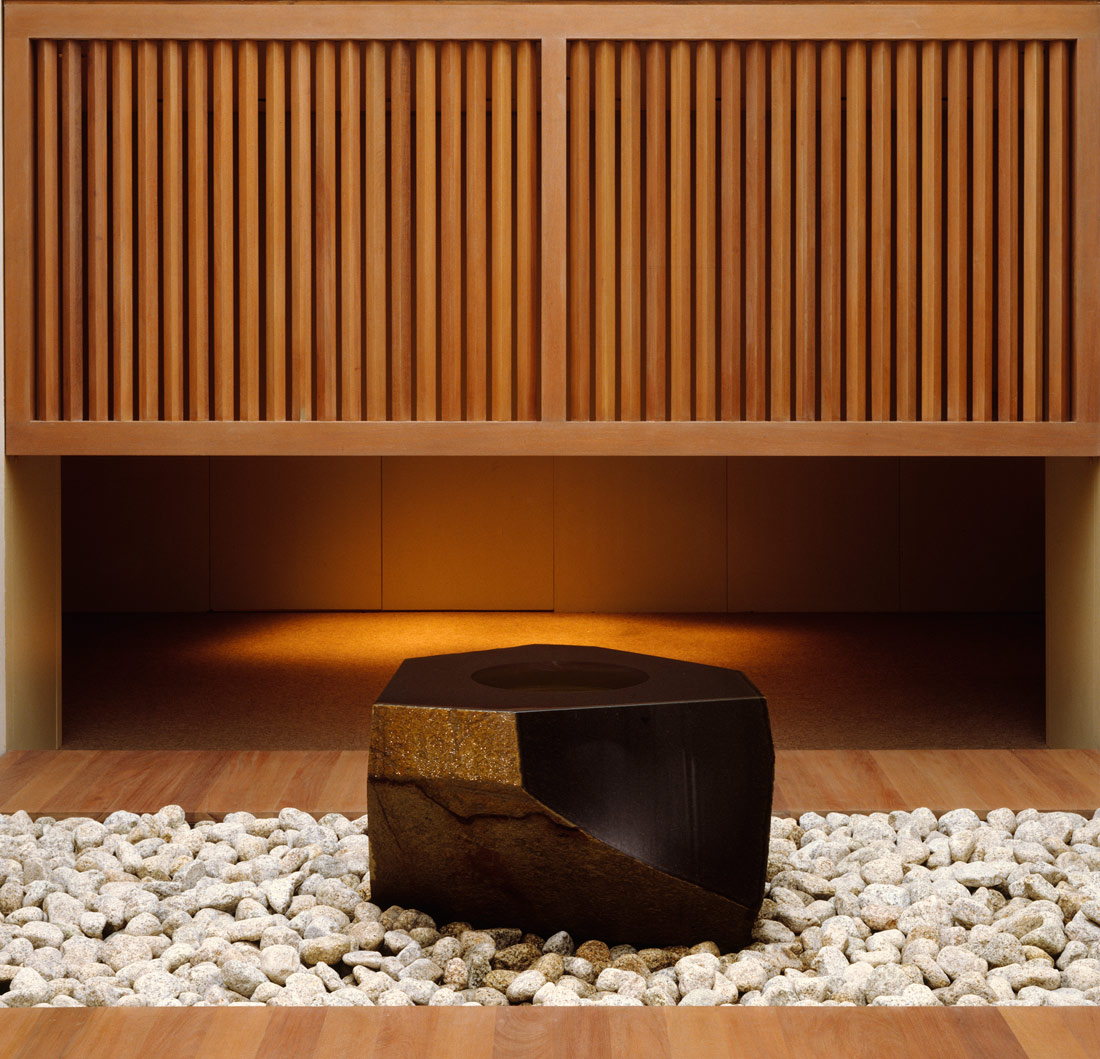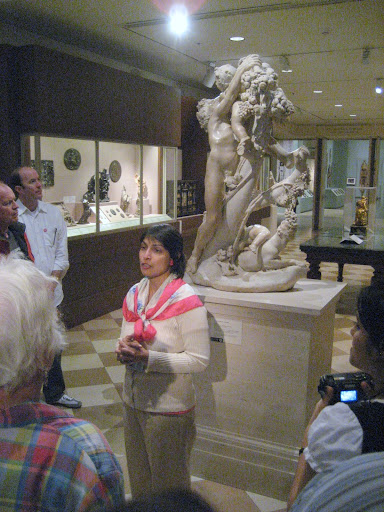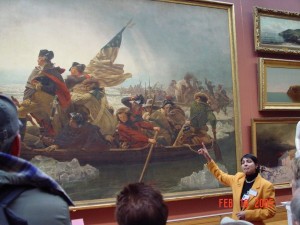
Though I also take visitors to see the gigantic painting of Washington Crossing the Delaware by Emmanuel Leutze, my friend and fellow-Docent Elizabeth Kahn Kaplan, is an expert on the canvas. I would prefer to let her research speak for itself. My thanks are due to Liz for sharing her wonderful insights into this seminal work with me. The essay that follows is based on Liz’s findings.
WASHINGTON CROSSING THE DELAWARE
Researched and written by Elizabeth Kahn Kaplan
Painted in 1851 by
Emanuel Gottlieb Leutze (1816-1868)
Oil on canvas; 149 x 255 in. (378.5 x 647.7 cm)
Signed and dated, lower right: “E. Leutze./Dusseldorf 1851”
Accession number: 97.34
Gift of John Stewart Kennedy, 1897
Location: American Paintings, Gallery #223, Second Floor, American Wing, Metropolitan Museum of Art
Before us is the largest framed painting at the Metropolitan Museum of Art– Washington Crossing the Delaware — over 12 feet high and more than 21 feet long. It is signed, lower right, “E. Leutze./Dusseldorf, 1851.” The artist is a German-born American, Emanuel Leutze, who chose a grand theme to make a grand statement, on a grand scale. The lifesize central figure of General George Washington leads his ragtag army – composed of ordinary Americans, representing many different nationalities, as illustrated by their varied headgear, and more than one race – across the Delaware River from Pennsylvania to New Jersey. They will march in silence nine miles south through a blinding snowstorm to Trenton, to surprise and overcome a much larger number of hired German soldiers – the Hessians – at their camp in Trenton. It is early morning, December 26, 1776, and the outcome of the battle to come will determine whether or not the cause of American independence will die that day.
The facts of the event:
In December of 1776, George Washington and his troops cross the Delaware River from Trenton to Bucks County, taking with them anything that might help the British in their pursuit. Following the manner in which war was fought at the time, each army went into winter quarters, the Americans in Pennsylvania and the British in New York and New Jersey. The British presence in Trenton is led by Colonel Johann Rall.
On December 25, Washington begins to cross the Delaware in the early afternoon. Ice in the river makes passage nearly impossible. It’s not until 4 am of December 26 that all of the army, including artillery, horses, and supplies, have crossed. In two groups — one along the Pennington Road and one along the river — the rebel forces march south.
On December 26, weary from a night spent responding to volleys from across the river in Morrisville, the Hessian soldiers sleep as General Washington sets his artillery at the northern entrance to Trenton. From this vantage, cannons can be fired down both King and Queen (today’s Warren and Broad) Streets. General Sullivan and his men fill the orchard behind the town’s barracks. As Sullivan begins shooting into the barracks building, Washington directs the cannon to open fire on King Street.
In short order the battle is over. Confusion reigns amongst the Hessian men. So total is Washington’s surprise attack that the Hessian leaders cannot even organize their men into cohesive action. Attempts are made to rally to the northeast and to the south. Over 900 Hessian soldiers are captured; another 150 die from their wounds, including the commander, Colonel Johann Rall. Washington and his men, along with their prisoners, return to their Pennsylvania quarters
Leutze began the painting some two generations after the event depicted. Mid-nineteenth century America was enjoying rapid growth and industrialization, making its mark among nations, and Americans were looking back at their beginnings with tremendous admiration of the Revolutionary War patriots and a worshipful regard of George Washington, both as general and first President. At the same time, the young nation was torn by tremendous friction between north and south over the issue of slavery — a division that would result in Civil War a decade later. The Black man in Leutze’s painting is meant to represent the MANY Black soldiers present at Washington’s crossing of the Delaware. Scholars have found that even New Hampshire, with a tiny population, had at least 180 Black male residents that served in the Revolution, most in the Continental Army, but others in the militia, the Navy, and aboard privateers. Oarsmen from Marblehead, Massachusetts under the leadership of Colonel John Glover who extricated the Patriot forces from Brooklyn after the Battle of Brooklyn Heights, rowed Washington’s forces across the Delaware River to engage the Hessians at the Battle of Trenton. The Marblehead regiment, in which so many seamen served, undoubtedly included many Blacks. Leutze’s inclusion in the boat of a black man makes clear his stand on the Free-Soil issue that divided his countrymen in the late 1840s. Both north and south revered George Washington, and Leutze hoped to remind Americans of his struggle to create the new nation, and how much would be lost if differences could not be settled peacefully.
Washington employed a largely ragtag army of volunteers and the tactics of guerrilla warfare to defeat the world’s most feared military power. His maneuvers to escape direct confrontation would be studied years later and serve as a model for Ho Chi Minh’s field commanders in Vietnam. He exhibited the temperament for leadership in war and in peace.
This is American history painting as Mythology – as the artist wanted us to see it. A traditional “history painting,” it depicts a contrived and exaggerated moment in history. History painting combines portraiture and action painting and requires a great deal of research. The work provided psychological support for both Germany’s ongoing revolution in the late 1840s-early 1850s, as well as sending a strong message to Americans: Hold onto the union; it’s too precious, created by the sacrifice of heroes.
The noble intention of every history painting is to provide inspiration.
The style is highly representative of a school of Romantic painting that flourished in Dusseldorf, where Leutze was living when he painted this picture in 1851. History painting was the highest calling for an artist; it combined portraiture with action painting; it required research.
Leutze used a number of elements to express this emotional, patriotic message. The painting is a masterpiece of composition. The central grouping forms a large triangle, with the flag at the apex and the boat as its base; the pole of the man on the left defines that side of the triangle, leading our eyes upwards to Washington and then to the flag; our gaze descends along the right side of the triangle towards the man rowing at the stern. Leutze spotlights two elements central to his theme: 1), the steadfast leadership of a determined George Washington, who would become the first president of the new nation, and 2), that this event would culminate in separation from England, symbolized by the almost erect flag of the new nation. It is held securely, and shielded, by 18 -year old Lieutenant James Monroe, as he struggles to keep the flag aloft as an inspirational symbol for the troops. He would be wounded in the battle, be elevated to Lieutenant Colonel, and live to become the fifth president of the United States.
Almost the entire upper half of the painting is suffused with light, surrounding and keeping our attention on these two main aspects – Washington and the flag.
Worthington Whittredge, one of the American artists present while Leutze was working in Germany, posed for the figures of both Washington and the steersman. The face was modeled on a cast of Jean-Antoine Houdon’s life mask of Washington.
The source of light is interesting. Leutze oriented his painting so that we face south as we look at the subject, in contrast to the usual placement of north at the top. Pennsylvania is to the west behind them, with New Jersey ahead, to the east. The little ship, crowded with symbolism, heads to the first light of a new winter dawn in the southeastern sky. It glows behind the two figures; had Leutze reversed the boat on the canvas, we would be facing north as we look at them, where the sky would still be dark. This light is unnaturally bright around the head; it shines on the right side of Washington’s face, (Jean-Antoine Houdon’s death mask of Washington was the model for it) outlining his profile and casting little light on the side facing us. A second source of light shines on the face of the soldier in brown. It is the same light surrounding the central group, and casts a shadow on the water in the foreground – a distortion of nature by the artist. Having light reflect off their bodies into the water, with painted shadows, gives a three-dimensional form to the figures, since our eyes know that when an object both reflects light and has a shadow it must also have volume. Without reflections and shadows, the figures would seem flat and two-dimensional. The sky is enhanced with a red, white, and blue rainbow behind the flag, heightening our emotional reactions to the painting. And, if you look closely toward the dawn-suffused sky, a morning star is shining – another symbol of a bright new day.
Red encircles and highlights the foreground — as an accent on the men’s uniforms and other clothing reflected in the water, and to a lesser extent on the clothing of the men in the second boat in the background. Colors fade in the distance, giving perspective to the painting.
Depicting motion is a technique painters use to keep our attention focused on the picture. We know the boat is in motion; the oars are pointing in different directions; the boat rocks as it struggles against the wind, the currents, and water filled with menacing ice floes splashing against the boat. We know the boat is making headway because the oarsmen are struggling to keep the boat on course. The flag, too, is moving, blown by the wind or the boat’s propulsion forward. Only one element does not move: Washington stands erect, resolute, focusing his thoughts on the future, not on the worries of the moment.
Leutze uses our sense of proportion to underline the precariousness of the men and the moment. The boat is far too small for the twelve men and the flag it carries. In reality Washington used a Durham boat, much larger and carrying 30 to 40 people. By decreasing the size of the boat relative to the figures inside, Leutze concentrates our attention on the physical struggle of the soldiers.
Leutze’s use of perspective creates an illusion of depth on the flat canvas surface. Objects and people in the background are smaller than those in the foreground. Colors are much brighter in the foreground; the second boat and its contents are painted duller shades to indicate distance. Leutze’s use of atmospheric perspective is masterful. The atmosphere in the background accounts for the softening of details and diminishing of light and dark contrasts. An atmospheric haze indicates the distance of the opposite shore. There are no sharp contrasts or outlines; the faraway boats fade in the distance just as they would in reality.
Also to heighten our perception of depth, the upraised arm of the oarsman near the front of the boat is foreshortened; even his right arm seems a little shorter than it would have been if it was extended straight down instead of at an angle toward the viewer.
Leutze uses thick paint and choppy brush strokes for the ice; less so for the boat – we can see the grain of the wood. Smooth brush strokes create a seamless sky, with colors blended into a soft glow. We are looking at the work of an artist in full control of his craft, fully achieving his objective.
Leutze also painted George Washington at the Battle of Monmouth, The Storming of the Teocalliby Cortez and His Troops (1848) now at the Wadsworth Atheneum in Hartford, CT, and Westward the Course of Empire Takes Its Way, which hangs in the U.S. Capitol.
BIBLIOGRAPHY:
I. Books and Catalogues
Boatmer, Mark M. III, Encyclopedia of the American Revolution. New York: David McKay Company, Inc., 1966.
Catton, Bruce, Editor, The American Heritage Book of the Revolution. New York: American Heritage Publishing Co., 1958
Dann, John C., ed., The Revolution Remembered: Eyewitness Accounts of the War for Independence.Chicago: University of Chicago Press, 1980,
Dwyer, William M., The Day Is Ours!: November 1776-January 1777: An Inside View of the Battles of Trenton and Princeton (How a Ragged Rebel Army Stood the Storm and Saved the Revolution. New York: The Viking Press, 1983
Fast, Howard, The Crossing. New York: William Morrow & Company, 1971
The Hessian: A Novel. New York: William Morrow & Company, 1972
Fischer, David Hackett, Washington’s Crossing. Oxford: Oxford University Press, 2004.
Frank, Sid, & Melick, Arden Davis, The Presidents Tidbits & Trivia. NY: Hammond Inc. 1984.
Franklin, John Hope, From Slavery to Freedom: A History of African Americans, p.77
Freeman, Douglas Southall, George Washington. (six volumes)
Gallagher, John J., The Battle of Brooklyn 1776. 1995
Groseclose, Barbara S., Emanuel Leutze, 1816-1868: Freedom Is the Only King. Washiington: Smithsonian Institution Press, 1975
Howat, John K., Washington Crossing the Delaware. Metropolitan Museum of Art Bulletin, vol. XXVI, 1968 (March), pp. 289-299.
Ketchum, Richard M., Divided Loyalties: How the American Revolution Came to New York. New York: Henry Holt & Co., 2002.Livingstons vs. Delanceys.
Lecke, Robert, George Washington’s War: The Saga of the American Revolution. New York: Harper Collins Publishing Company, 1992.
Library of Congress: The Papers of George Washington, Washington, vol. iv. p. 364
Logan, Rayford W., and Winston, Michael R., ed. Dictionary of American Negro Biography, p.643
Lowell, Edward J., The Hessians And The Other German Auxiliaries Of Great Britain In The Revolutionary War. New York: Harper and Brothers Publishers, 1884
McCullough, David, 1776. New York: Simon & Schuster, 2005.
McPhillips, Martin, The Battle of Trenton: Turning Points in the American History Series.
Morristown, N.J.: Silver Burdett Company, 1985.
The Metropolitan Museum of Art GUIDE, 2nd edition. New York: Metropolitan Museum of Art, 1994, p. 24.
Mitnick, Barbara, ed., George Washington: American Symbol. New York: Hudson Hills Press and The Museums at Stony Brook, 1999.
Randall, William Sterne, George Washington: A Life. New York: Henry Holt & Company,1997.
Raphael, Ray, A People’s History of the American Revolution: How Common People Shaped the Fight for Independence. New York: The New Press, 2001.
Rogers, Joel A., Africa’s Gift to America, p.107, 110-111
Schecter, Barnet, The Battle for New York: The City at the Heart of the American Revolution. New York: Walker and Company, 2002
Spassky, Natalie, and others, American Paintings in the Metropolitan Museum of Art, volume II, pp. 16-24. Metropolitan Museum of Art, 1985.
Styker, William S. The Battles of Trenton and Princeton,1898
Wallace, William M., Appeal to Arms: A Military History of the American Revolution. New York: Harper & Brothers, 1951.
Other books:
Groseclose, Barbara, Emanuel Leutze 1816-1868, Freedom is the Only King. Washington : Published for the National Collection of Fine Arts by the Smithsonian Institution Press : For sale by the Supt. of Docs., U.S. Govt. Print. Off., 1975.
About John Glover and/or the Marblehead Mariners
Beattie, Donald W., and Collins, J. Richard, Washington’s New England Fleet.
Billias, George Athan, General John Glover and his Marblehead Mariners
Smith, Phillip C. F., and Knight, Russell W., In Troubled Waters: The Elusive Schooner Hannah Waite, Henry E., Origin of the American Navy
II. Metropolitan Museum of Art Gallery Talk
Schwarz, Alice, Education Department, Metropolitan Museum of Art/
III. Internet Web Addresses
http://tencrucialdays.com Click on the links “Other Historic Sites” and “Other Links”
The Hessians
http://www.barracks.org/barracks.org/barracks/battle1.html
Prince Whipple and/or the Role of Blacks During the Revolution Seacoast NH Black History: Prince Whipple In American Painting.
http://www.seacoastnh.com/blackhistory/prince.html
http://www.seacoastnh.com/brewster/28.html
For the most up-to-date research about Prince Whipple (who is NOT depicted in Leutze’s painting) Write to: Valerie Cunningham, African American Resource Center
369 Greenland Rd, Portsmouth NH 03801
Click here to continue the tour to see the Autumn Landscape Window by Louis Comfort Tiffany.
